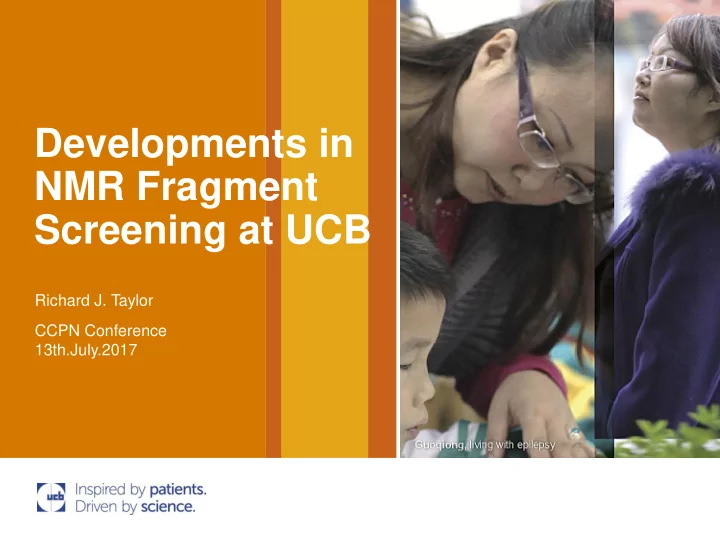

Developments in NMR Fragment Screening at UCB Richard J. Taylor CCPN Conference 13th.July.2017
High Quality, Soluble, Chemically Diverse Fragment Subset
NMR Hardware AVIII HD 600 MHz. 5 mm QCI-F He Cryoprobe SampleJet with cooling
Assemble 19 F NMR database Collaboration with ACD/Labs to automate 19 F NMR ligand screening Construct Screening Cocktails Automated Deconvolution • 19 F NMR screen is sufficiently rapid to allow ranking in proteins for STD screening • High hit rates may be indicative of non-specific binding
Results of 19 F CPMG Screens Target A • 131 hits (12 %) • 94 / 131 confirmed by STD NMR (20 strong) • Crystal structure of 2 of the hits Target B isoform 1 • 30 hits (3 %) • 18 / 30 confirmed by STD NMR (6 strong) Target B isoform 2 • 24 hits (2 %) • 18 / 24 confirmed by STD NMR (8 strong) Target B isoform 3 • 15 hits (1.4 %) • 8 / 15 confirmed by STD NMR (8 strong) Target C (tetrameric ion channel) • 18 hits (1.6 %) • 11 / 18 confirmed by STD NMR (7 strong) • HSQC interaction site mapping of 2 of the hits UCB: Christine Prosser, Zara Sands UoL: Philip Renshaw, Sarah Strong, Gareth Hall, Lorna Waters, Vaclav Veverka, Mark Carr
Protein Observe experiments (HSQC, HNCO) are information rich BUT are often dismissed …. “….uses too much protein” “…. is too slow to inform Medicinal Chemistry iteration” Ph.D. Studentship Goals: • Increase sensitivity • Decrease sample consumption • Reduce data acquisition time
Problem: 2D Experiments are slow Shaped Pulses Optimise Spectral Width ASCOM Ernst-angle excitation cos(θ ) = e -(d1+at) / T1 Fast Pulsing Fewer Scans Non-Uniform Sampling of t1 t 2 BEST-TROSY SOFAST-HMQC t 1 band-Selective Optimised Flip-Angle Short-Transient (SOFAST) Band-selective Excitation Short Transient (BEST) Tranverse Relaxation Optimised SpectroscopY (TROSY) Dr. Matthew Goodwin Automated Spectral COMpression (ASCOM)
BEST-TROSY – Reducing D1 Standard BEST-TROSY TROSY 294 μ g 9.5 hours 294 μ g 3.5 hours Shaped pulses No shaped pulses Faster scans – Slower scans – interscan delay interscan delay 1s 0.25 s More scans in same time 1.6x more S/N Allows time reduction from 9.5 h to 3.5 h 100 μ M 42 kDa protein Dr. Matthew Goodwin
Buffer Optimisation Buffers: • Proteins require salt for solubility and stability, however, salt reduces S/N • Low salt buffers result in a ~20 % increase in peak intensity Increase relaxation: • Gd 3+ chelate based contrast agents • ~ 1mM Gadbutrol, available commercially as Gadovist, used as an MRI contrast agent Phosphate Buffered Arg-Glu Buffer Saline Gd 3+ - Sibille et al. Low concentrations of a Gd-chelate increases the signal to noise ratio in fast pulsing BEST experiments. J. Magn. Reson. 224, 32-37 (2012) Dr. Matthew Goodwin
700 MHz 1.7 mm Microcryoprobe • Bruker 700 MHz 1.7 mm microcryoprobe ~ 5x the mass sensitivity of the 600 MHz. 5mm cryoprobe • Optimised for sample volumes of 35 µL – rather than 70-600 µL in a 5mm probe • Tube based operation • SampleJet for automation • Gilson 215 robot for sample preparation High Sensitivity - Low volume - Automated Prof. Matthew Crump, Dr. Matthew Goodwin
SOFAST 1 H- 15 N HMQC 700 MHz 1.7 mm Microcryoprobe 25 μ M 15 N IL6 (~18 μ g) 1 mM ligand Arg Glu buffer 1 hour ( cf 100 μ M 15 N IL6 (~147 μ g) 1 mM ligand 30 minutes at 600 MHz in 70 m L Schanda et al . SO-FAST HMQC experiments for recording two-dimensional heteronuclear correlation spectra of proteins in a few seconds. J. Biomol. NMR, 33, 199-211 (2005) Dr. Matthew Goodwin
Ligand Observe - 700 MHz 1.7 mm Microcryoprobe WaterLOGSY 25 μ M IL6 (~18 μ g) 1mM binder 6 PBS, 10% D 2 O Binders 5 minutes (and water) Saturation Transfer Non-Binders Difference 25 μ M IL6 (~18 μ g) 1mM binder 6 PBS, 63% D 2 O 15 °C 8 minutes 63% D 2 O, 15 C, 8 mins experiment time are optimised conditions for acquisition of STD and WaterLOGSY on the same sample with sufficient S/N. Water Ligand Observe via Gradient SpectroscpY (WaterLOGSY) Dr. Matthew Goodwin
Conclusion A series of options each offer incremental improvements in sensitivity and acquisition rate • 1.7 mm Microcryoprobe • 25% NUS with Compressed Sensing reconstruction • Arg-Glu Low Conductivity Buffers Chelated PREs (e.g. Gadbutrol) • • Optimisation of SOFAST-HMQC ( <20k Da) and BEST TROSY (>20 kDa) For Example To screen 1000 fragments by STD and To screen 100 compounds by protein detect waterLOGSY on microcryoprobe: 15 N- 1 H SOFAST on microcryoprobe: • ~20 days, ~18 mg protein • 4 days, ~180 μ g protein • Compares to ~7 days ~62 mg on 5 mm • Compares to ~1 days ~31 mg on 5 mm probe, running in 5 ligand mixtures, probe plus deconvolution experiments No ideal single solution – still need to compromise Likely to be protein and application specific Dr. Matthew Goodwin
Where next? GPRCs and lipodisqs (SMALPS) Antibody Assisted Drug Discovery Selective labelling strategies Explore application of APSY for 3D NHCO fragment screening IDPs by Solid State NMR Automated Projection SpectrocscopY (APSY) Ralph Adams, Rebecca J. Burnley, Chiara R. Valenzano, Omar Qureshi, Carl Doyle, Simon Lumb, Maria del Carmen Lopez, Robert Griffin, David McMillan, Richard D. Taylor, Chris Meier, Prashant Mori, Laura M. Griffin, Ulrich Wernery, Jörg Kinne, Stephen Rapecki, Terry S. Baker, Alastair D. G. Lawson, Michael Wright and Anna Ettorre
Acknowledgements Professor Matthew Crump Professor Mark Carr Dr. Matthew Goodwin Dr. Lorna Waters Erik Landin Dr. Vaclav Veverka Dr. Frederick Muskett Dr. Christine Prosser Harry Mackenzie Dr. Alistair Henry
20 Questions?
Recommend
More recommend